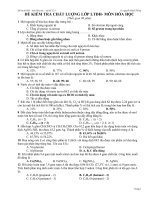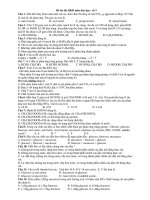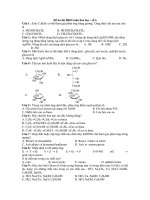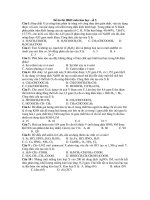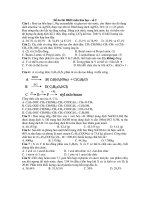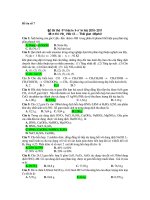Đề ôn thi thử môn hóa (734)
Bạn đang xem bản rút gọn của tài liệu. Xem và tải ngay bản đầy đủ của tài liệu tại đây (123.81 KB, 5 trang )
838
S E C T I O N V I Pediatric Critical Care: Neurologic
with longer PICU stay and increased morbidity, suggesting that
some patients may benefit from electrolyte monitoring and correction of hyponatremia.11
Symptoms that are strongly supportive of GBS include the
relative symmetry of symptoms, mild sensory symptoms, cranial
nerve involvement, autonomic symptoms, and recovery that usually begins 2 to 4 weeks after symptom progression ceases. Sphincter disturbances rarely occur early in the course of GBS and are
usually transient.12,13
Diagnostic studies include examination of the CSF and nerve
conduction studies. The CSF reveals elevated protein (.45 mg/
dL) and a relative paucity of white blood cells (WBCs), usually
less than 10 cells/mL, with protein increasing after the first week
of symptoms.12 Electrodiagnostic testing reveals motor conduction velocities in the demyelinating range, conduction block,
temporal dispersion, and prolonged F waves. Bradshaw and
Jones6 reported that conduction block and temporal dispersion
occurred in 74% of the patients.
It is important to recognize that the patients may need intensive care. Criteria for PICU care include rapidly advancing weakness, flaccid quadriparesis, bulbar symptoms, vital capacity less
than 20 mL/kg, and cardiovascular instability.13 If the symptoms
are severe, treatment options for GBS primarily include plasmapheresis and intravenous immunoglobulin (IVIG). Based predominantly on adult literature, the American Academy of Neurology has published practice guidelines providing treatment
recommendations.14,15 First, plasmapheresis and IVIG both hasten recovery, and neither is more efficacious. Using these two
treatments sequentially is not superior to either treatment alone.
Finally, corticosteroids do not seem to improve outcome.16 The
decision of which therapy to apply to children is controversial
because there has not been a large randomized study performed.
Plasmapheresis may be technically difficult in small children;
therefore, immunoglobulin is often used as the first intervention.
Favorable improvement in pediatric patients treated with immunoglobulin has been reported in several small series and on Cochrane review.17–20 A randomized trial in children showed that
fewer relapses occurred if 2 g/kg of IVIG were divided over 5 days
instead of 2 days.20 If additional courses of IVIG are necessary, a
2-day protocol is often well tolerated.
Several GBS variants exist. The best known are the Miller
Fisher variant and acute inflammatory axonal polyneuropathy, the
axonal form of GBS. The neurologic triad found in the Miller
Fisher syndrome includes ataxia, areflexia, and ophthalmoparesis.
Miller Fisher syndrome has been linked to immunoglobulin G
(IgG) antibodies against ganglioside GQ1b.21 In some C. jejuni
strains, molecular mimicry exists between the surface epitopes
and ganglioside GQ1b.22 The GQ1b ganglioside is thought to
cross-react in the brainstem area of the ophthalmic cranial
nerves.23 The axonal form of GBS has been associated with a more
prolonged recovery than the classic form of GBS due to axonal
involvement. Early research suggests that CSF levels of neurofilament correspond to levels of axonal damage on EMG testing and
may help complement EMG studies to help predict patients with
more prolonged recoveries.24,25
Myasthenia Gravis
Myasthenia gravis (MG) has many forms that may present in the
pediatric population. The juvenile form of MG is the most common and is clinically identical to the autoimmune adult form of
MG. Overall, however, juvenile MG is rare and comprises 10% of
all cases of MG in Western populations. Antibodies directed
toward the acetylcholine receptor (AChR) at the postsynaptic
neuromuscular junction cause this form of the disease. These antibodies result in blockade of the AChR, increase the degradation
of the AChR, and result in complement damage to the AChR.26
AChR antibodies are found less frequently in juvenile MG
compared with adult autoimmune MG and are more easily
demonstrated in the postpubertal patient population.27 Anticholinesterase antibody levels should be drawn in all patients with
suspected MG, however. Newer assays are identifying antibodies
previously missed in older anticholinesterase antibody assays,
including binding, blocking, and modulating antibodies, but
these may need to be ordered separately.28–30
The most common heralding symptoms of weakness in MG
include ptosis (with pupillary sparing) and diplopia from restricted eye movements. These symptoms wax and wane, and the
weakness may generalize to the extremities. The two clinical forms
of juvenile MG are ocular and generalized. In ocular MG, symptoms include ptosis and diplopia, but the weakness does not
progress to other areas of the body. Generalized MG may begin
with ocular symptoms and progress to generalized weakness, usually within 1 year of onset. However, generalized weakness may be
the initial presentation. As in adults with MG, pediatric patients
have fewer symptoms in the morning or after rest. Increasing fatigability with exercise is an important hallmark of this disorder.
The most troublesome symptoms in generalized MG are those
involving bulbar muscles (difficulty chewing and swallowing),
respiratory muscles, and exercise intolerance.
When a patient is suspected to have MG, the classic diagnostic
bedside test is the edrophonium (Tensilon) challenge. Edrophonium is an intravenous short-acting anticholinesterase preparation that has limited availability in many hospitals. The dosing
in infants is 0.15 mg/kg and 0.20 mg/kg (maximum, 10 mg) in
older children. Only 10% of the entire dose is given initially so
that the clinician can observe for muscarinic side effects. Atropine
(0.015–0.040 mg/kg) should be available for these possible side
effects, which include bradycardia and respiratory distress secondary to bronchial secretions and bronchospasm. After the
trial dose is tolerated, the entire dose is then given. In lieu of
edrophonium, neostigmine is given at a dose of 0.025 to 0.050
mg/kg intramuscularly. The patient should be observed during
the trial for changes in ptosis or fatigability. The onset of action
with edrophonium is approximately 30 to 90 seconds after intravenous delivery and remains for approximately 5 minutes.
Neostigmine has an onset of action within 15 minutes, and effects may last for 1 hour. Many clinicians also perform a blinded
placebo trial of normal saline.
The neurodiagnostic study used in patients with suspected MG
is repetitive nerve stimulation. This study is best performed on
proximal muscles, although distal muscles are often studied. The
confirmatory finding on repetitive nerve stimulation is a 10%
decrement in amplitude of the compound muscle action potential.
Antibodies have been found that can block, bind, or modulate
AChR. Approximately 80% of patients will have antibodies to
AChR found in standard assays. Antibodies directed against
muscle-specific kinase (MuSK) appear to account for some of the
remaining 20%.28 Newer, more sensitive assays can also identify
antibodies with low affinity for AChR.30 Clinically, MuSK-positive patients tend to have more frequent bulbar involvement and
respiratory crises than AChR-positive patients and require larger
doses of maintenance corticosteroids, though there is no clear difference in clinical outcomes.31 Seronegative (AChR-negative and
CHAPTER 68 Acute Neuromuscular Disease and Disorders
MuSK-negative) patients have a disease severity between the other
two groups but appear to have better clinical outcomes.31
Treatment of MG begins with anticholinesterase medications.
The symptoms of MG usually respond to pyridostigmine bromide
(Mestinon), the most common oral form of anticholinesterase
medication. The dosage of pyridostigmine bromide is 7 mg/kg per
day divided four to six times daily as needed for symptoms. Immunosuppressant agents—including prednisone, azathioprine,
cyclophosphamide, tacrolimus, and rituximab—may be added to
the regimen for pyridostigmine nonresponders.32 Mycophenolate
mofetil may also be prescribed though it has not proved more efficacious than placebo in two randomized trials of patients already
on prednisone.33–35 However, a subsequent study with an extended outcome duration, greater than 25 months compared with
9 months in the previously mentioned studies, demonstrated that
mycophenolate mofetil might be effective as either adjunctive
therapy with prednisone or monotherapy, but maximum results
may not be seen for greater than 1 year.33 Prednisone is usually
initiated at 1 to 2 mg/kg per day. Clinicians must be careful with
the use of prednisone because it may exacerbate weakness on
initiation.
Many studies have suggested that beneficial effects of thymectomy are best when performed early in the course of MG.27,36,37
Because of the spontaneous remission rate reported by Rodriquez
et al. as 22.4 per 1000 person-years, however, many clinicians are
reluctant to proceed with early thymectomy, particularly with
young children.38
Myasthenic crisis is an exacerbation of myasthenic symptoms
requiring ventilatory assistance. In adult MG, myasthenic crisis
has been reported to occur in 15% to 20% of patients, with 74%
having their first crisis within 2 years of disease presentation.39,40
Anlar et al. reported that one-third of patients with juvenile MG
had at least one episode of crisis.41 Initial therapy during crisis
includes mechanical ventilation, which provides rest for the weakened patient.
Anticholinesterase medications should be discontinued during
a crisis because they increase secretions that could lead to mucous
plugging. Myasthenic crisis is most commonly heralded by infection
in 38% of patients; however, 30% of patients have no obvious
trigger for their crisis other than respiratory or bulbar weakness.40
A thorough investigation for the cause of crisis should be undertaken.
Plasmapheresis and IVIG (2 g/kg over 2 to 5 days) also play a
role in the treatment of myasthenic crisis and acute exacerbation
of myasthenic symptoms. In adult crisis, plasmapheresis has been
shown to be more efficacious than IVIG. However, plasmapheresis is associated with more complications, including cardiovascular and infectious complications.42 IVIG has been shown to be
superior to placebo in a randomized controlled trial, with significant improvements seen as early as 14 days after infusion and
lasting through 28 days.43 Evidence supports the use of IVIG for
treatment in myasthenic crisis or exacerbation in patients in
whom plasmapheresis is not feasible.
Cholinergic crisis must also be a consideration in a patient
with an MG exacerbation. Cholinergic crisis occurs with an overdose of anticholinesterase drugs in patients with MG. The overdose causes depolarization of skeletal muscles and muscarinic side
effects, including increased secretions, diarrhea, lacrimation,
sweating, and bradycardia. These symptoms will improve on
withdrawal of the anticholinesterase medications. Some authors
argue that cholinergic crisis is rarely the cause for worsening
myasthenic symptoms.39,44
839
The clinician must always be cautious when initiating new
medications in the patient with MG. Many drugs interfere with
the neuromuscular junction; the best known are the aminoglycoside medications. Although not well recognized, corticosteroids
can also exacerbate weakness in a patient with MG. For this reason, one must be cautious when beginning prednisone in the
patient with refractory MG, observing closely for any initial increased weakness. Other antibiotics that have been implicated in
the worsening of myasthenic symptoms include ampicillin, ciprofloxacin, clindamycin, erythromycin, sulfonamide, tetracycline,
and the peptide antibiotics (polymyxin A and B, and colistin).
Cardiovascular medications—including the antiarrhythmics
(quinidine, procainamide, and lidocaine) and b-blockers—have
also been reported to worsen symptoms. Thyroid replacement
medications and phenytoin may also cause problems. The neuromuscular junction blockers—including vecuronium, rocuronium,
and pancuronium, as well as succinylcholine—should be used
with caution because the effects of these medications are prolonged in patients with MG.44,45 At www.myasthenia.org, the
Myasthenia Gravis Foundation of America maintains a list of
medications to avoid and to use with caution.
Approximately 16% of patients with juvenile MG exhibit additional autoimmune disease,38 and may have asthma, rheumatoid arthritis, juvenile diabetes mellitus, hyperthyroidism, chronic
inflammatory demyelinating polyneuropathy, and CNS demyelination.38,46,47 Seizures have also occurred in 4% to 12% of patients with juvenile MG, although the exact cause is not known.38
Congenital and Transient Neonatal
Myasthenia Gravis
The other forms of MG are congenital MG and neonatal transient
MG. Neonatal transient MG is unique in neonates who are born
to mothers with autoimmune MG. Neonates can manifest symptoms of neonatal transient MG even if the mothers were symptom
free during pregnancy and delivery. Neonatal transient MG
occurs in approximately 12% of infants born to mothers with
MG.48 If a mother with MG gives birth to an infant with neonatal MG, her subsequent neonates are also at increased risk of having this transient disorder. Neonatal MG usually resolves in the
first few weeks after birth, when the maternally derived antibody
level diminishes in the neonate. Results from several studies have
shown that even symptom-free infants born to mothers with MG
have elevated titers of AChR antibodies.49 Additionally, the same
phenomenon has been reported in infants born to mothers with
anti-MuSK.41 The antibody concentration of the symptom-free
neonate rapidly decreases when compared with the antibody concentration of a neonate with symptoms.50 The symptoms of neonatal transient MG usually include hypotonia, feeding problems
(particularly fatigue), weak cry, and respiratory difficulty. Treatment of these symptoms is supportive, with anticholinesterase
medications used for severe symptoms.
Congenital MG usually presents in childhood, with symptoms
similar to those of juvenile MG. Many defects are responsible for
causing symptoms in congenital MG, including congenital abnormalities resulting in presynaptic, synaptic, or postsynaptic
defects of the neuromuscular junction.51 Congenital MG is always negative for ACh antibody, and a family history of congenital MG may or may not be present. The inheritance of congenital
MG may be autosomal recessive or dominant, or sporadic.51
Treatment of congenital MG is different from the treatment of
840
S E C T I O N V I Pediatric Critical Care: Neurologic
juvenile MG because immunosuppression does not play a role.
Symptoms of congenital MG may or may not respond to anticholinesterase medications.
Tick Paralysis
The clinician must always entertain tick paralysis in the differential diagnosis of acute flaccid paralysis in children. On presentation, patients with tick paralysis may be mistakenly diagnosed
with GBS. The treatment of the two diseases is distinct; therefore,
a high index of suspicion for tick paralysis should be maintained.
Affected patients are usually between the ages of 1 and 5 years.
A review of 33 patients with tick paralysis reported that 82% were
younger than 10 years of age and 76% were female.52 Longer
hairstyles have been speculated to be the cause of this female preponderance. A thorough examination of the patient should ensue
because more than one tick may be attached. The ticks most commonly implicated in North America are Dermacentor andersoni
(wood tick) and Dermacentor variabilis (dog tick). However, other
types of ticks have also been documented.53 In Australia, the most
common tick variety to cause paralysis is Ixodes holocyclus.53 The
cause of the weakness is a neurotoxin that is secreted in the saliva
of the gravid female tick. The neurotoxin is produced during the
engorgement phase of feeding after mating. The neurotoxin inhibits the release of acetylcholine at the presynaptic terminal.53
The symptoms in North American hosts begin with vague
complaints of fatigue, irritability, and pain. Vague symptoms may
not begin until approximately 5 days after tick attachment but
then progress rapidly.54 Symptoms may also include cerebellar
signs, such as ataxia.54 If the tick remains attached, a symmetric
ascending flaccid paralysis with areflexia develops. Subsequently,
bulbar and facial weakness as well as respiratory involvement occur. No systemic features are seen in tick paralysis. Patients are
afebrile with normal vital signs, erythrocyte sedimentation rate
(ESR), CSF, and mental status. The removal of the tick results in
the rapid reversal of symptoms, usually within 24 hours.
On discovery, the tick needs to be promptly removed. Removal
of the tick is performed with blunt curved forceps or tweezers.
The tick should be grasped at the point of attachment, as close to
the skin as possible. The tick should be pulled upward with steady
pressure. Twisting or jerking motions may cause parts of the tick
to break off, particularly the mouth parts. The tick should not be
handled with bare hands. Needham55 evaluated various methods
of tick removal, including fingernail polish, petroleum jelly, 70%
isopropyl alcohol, and a hot kitchen match. None of these passive
techniques induced tick detachment.
Tick paralysis is more severe in Australia than in North America. The presenting symptoms are similar to those in the North
American cases; however, ocular involvement with nonreactive
pupils has been described.56 Flaccid paralysis may take days to
evolve, unlike in North American hosts. The major difference in
Australian tick paralysis occurs after the tick is removed. Australian patients must be carefully observed because maximal weakness may not occur until 48 hours after tick removal.56
Periodic Paralyses
Clinicians may encounter various forms of periodic paralysis (PP),
including hypokalemic and hyperkalemic. Most forms of the PPs
include a family history of the disease. Weakness that eventually
results in paralysis is associated with potassium responses, as demonstrated in hyperkalemic or hypokalemic PP. PP may also be
accompanied by abnormal cardiac rhythms, including prolonged
QT, as in Andersen-Tawil syndrome; checking an electrocardiogram may be prudent regardless of the serum potassium level.57
Andersen-Tawil consists of a triad of ventricular dysrhythmia, PP,
and dysmorphic features.58 Hypokalemic and hyperkalemic PP
are discussed in detail at ExpertConsult.com.
Botulism
Infantile botulism is a syndrome predominately found in infants
6 days to 12 months of age.84 In infantile botulism, Clostridium
botulinum enters the body as a spore through ingestion. Germination occurs, and the organism begins to produce the neurotoxin that
is the cause of the symptoms.85 It differs from food-borne botulism,
in which the preformed toxin is actually ingested. In mouse models,
the relationship of the gut and spores is important, with the pH of
the gut and transient lack of competitive intestinal flora being essential in allowing the spores to germinate.84 Infants appear to be
susceptible, as are adults who have abnormal intestinal flora from
abdominal surgery, gut abnormalities, or antibiotic use.86–89
Most cases of infantile botulism occur in California, Pennsylvania, and Utah. In one report, more than 75% of the patients with
botulism had C. botulinum in their home environment.90 Other
sources include soil disruption from cultivation or construction
and parental occupations that involve soil exposure.91 The consumption of honey and corn syrup is a risk factor. Children
younger than 12 months should not be fed these products. The
disease-modifying role of breast-feeding remains controversial.92,93
The botulinum toxin irreversibly binds at the presynaptic segment of the neuromuscular junction, inhibiting acetylcholine release and causing neuromuscular weakness. The autonomic system
is also affected because the toxin binds the acetylcholine-mediated
preganglionic parasympathetic and sympathetic synapses as well as
the postganglionic parasympathetic synapse.94
The most common symptoms include weak cry, poor suck and
feeding, decreased tone with decreased reflexes, weakness in a
descending pattern, and constipation.94 Autonomic symptoms,
often the first to appear, include constipation, tachycardia, fluctuating blood pressure, urinary retention, decreased tears and saliva,
and flushed skin or pallor.84,95 L’Hommedieu and Polin95 proposed an algorithm of symptoms beginning with tachycardia and
constipation and progressing to loss of head control, difficulty
feeding, and weak cry. A depressed gag reflex is followed by peripheral muscle weakness and, finally, diaphragmatic weakness.
Because of the combination of autonomic and neuromuscular
symptoms, the infant with botulism may be mistaken to be septic
or dehydrated. Enlarged, sluggishly reactive pupils may also be
present but are less common than the other autonomic symptoms.96 The most concerning consequence of botulism is respiratory embarrassment. Schreiner et al.94 reported that only 24%
of the patients reviewed did not require ventilation or an artificial airway. Patients with botulism have also become apneic
during procedures, including lumbar puncture and IV catheter
placement.94 Hypoxic ischemic encephalopathy resulting from
respiratory arrest has been described as well as syndrome of
inappropriate secretion of antidiuretic hormone, urinary tract
infections, pneumonia, and autonomic instability.94,96 Aminoglycosides exacerbate the neuromuscular blockade and should
be avoided in botulism.97
The diagnosis of botulism is clinical but confirmed by isolation
of the organism or toxin in stool. Electromyography (EMG) in
patients with botulism reveals decreased compound motor action
840.e1
Hypokalemic Periodic Paralysis
Hypokalemic periodic paralysis (HypoPP) is the most common
form of the PPs. The presentation of HypoPP usually occurs
within the second decade of life. Number of attacks, which may
be frequent, usually decrease as patients get older. Occurrence
of HypoPP is 1 in 100,000 people. The inheritance pattern of
HypoPP is autosomal dominant, with males more frequently affected, but one-third of cases are sporadic.59 The most common
mutation in familial HypoPP is the dihydropyridine receptor in
the voltage-sensitive Ca21 channel, located on chromosome 1q.60
Another common mutation is a voltage-sensitive sodium channel,
SCN4A.59,61,62 No mutation is found in a minority of cases.62,63
Onset of symptoms in HypoPP usually occurs after the consumption of a high-carbohydrate meal or after vigorous exercise
followed by rest. Other provoking factors include cold temperature, emotional stress, menses, and pregnancy. Weakness usually
begins during sleep, with the patient noticing weakness on awakening. Initially, the weakness is proximal in the legs and then
progresses distally before involvement in the upper extremities. It
may progress to flaccid paralysis of all limbs, with areflexia and
normal sensation. Cranial nerve function remains normal, with
swallowing and respiratory function rarely affected. The patient
remains alert, with a normal mental status during the attack, and
sensation remains intact. Weakness typically lasts a few hours but
may last several days. On noticing the initial symptoms of mild
muscle cramping, or “heaviness,” some patients are able to abort
an attack with light exercise.63,64 Sudden death from cardiac arrhythmias or respiratory failure has been reported.64–66 During
paralytic attacks, patients have minimal urine output, with decreased potassium excretion and absent defecation.63,67 In HypoPP, myotonia confined to the eyelids has been described.68
Before this report, myotonia was described as occurring only with
hyperkalemic periodic paralysis (HyperPP).
Diagnosis of HypoPP can be confirmed with the identification
of hypokalemia during an attack. Laboratory testing during HypoPP reveals a markedly diminished serum potassium concentration. Although serum potassium levels are decreased, the total
body amount of potassium remains normal. The decreased potassium level is due to a shift of the potassium into the muscle cells,
resulting in in-excitable muscle cells.69 During an attack, potassium levels usually fall below 3, but levels below 2 have been
reported.70 Secondary causes of hypokalemia—such as Bartter
syndrome, corticosteroids, diuretics, hyperaldosteronism, laxatives,
licorice, renal tubular acidosis, amphotericin B, p-aminosalicylic
acid, alcoholism, and villous adenoma—must be ruled out.71
The paralytic attack may be reversed with normalization of the
potassium level. The clinician must be careful when correcting
the potassium level, remembering that the total body amount
of potassium remains normal. Correction with oral potassium
(0.2–0.4 mmol/kg every 15–30 minutes) should be considered.
Patients with cardiac symptoms or an inability to swallow, however, require parenteral potassium.71 While the potassium level is
corrected, vigilant cardiac monitoring, serial potassium levels, and
muscle strength examinations should be undertaken. IV fluids
with dextrose or physiologic saline should be avoided because
they may prolong an attack or even induce cardiac arrhythmias.71,72 Griggs et al.73 reported that 5% mannitol solution
should be considered as a diluent for IV potassium replacement.
Links et al.63 studied a large kindred with HypoPP and reported that all family members older than 50 years had permanent muscle weakness. The authors concluded that while all patients eventually exhibit permanent muscle weakness, only 60%
may have paralytic attacks.
Once a patient is known to have HypoPP, prophylactic medications should be initiated. Acetazolamide has been shown to
prevent future attacks in patients with and without a family history of the disease when daily doses of 250 to 750 mg are administered.71 Some patients, however, have been reported to have an
exacerbation of attacks when taking acetazolamide.74 Another report revealed that acetazolamide prophylaxis improved strength
between attacks in 80% of patients who displayed persistent
weakness between paralytic attacks.73 Daily oral potassium chloride does shorten the duration of the attacks but does not appear
to prevent attacks.73 Other medications used for prophylaxis
of attacks include triamterene and spironolactone in patients
not responsive to acetazolamide.73,74 Considerations for the
prevention of attacks include avoidance of high-sodium, highcarbohydrate meals, prolonged rest, and arduous exercise.
Thyrotoxic PP is another entity of weakness with concomitant
hypokalemia. As the name implies, a thyrotoxic state underlies
this disease. It is mostly found in adult Asian males, although it
has been reported in Asian-American children.75 Treatment of this
disease focuses on alleviation of the hyperthyroid state (see also
Chapter 84).
Hyperkalemic Periodic Paralysis
The term hyperkalemic periodic paralysis (HyperPP) may be
misleading because high, normal, and low levels of potassium
have been reported in these attacks.76 The name HyperPP actually
correlates to the response that these patients have to potassium.
HyperPP is also referred to as potassium-sensitive PP, which may
be more appropriate and less confusing. HyperPP is autosomal
dominant, with a common gene located on chromosome 17q
affecting the a-subunit of the sodium channel, but other sodium
channels may also be affected.59,77,78 Sporadic cases have been
reported as well.59,79 HyperPP usually presents in the first decade
of life.
Rest after exercise is the most common provoking feature.
Other provoking factors include cold temperatures and meal skipping. The pattern of weakness is similar to HypoPP: the legs are
usually affected before the arms, with symmetric weakness. Weakness during the attacks varies from mild to flaccid quadriplegia
with areflexia, but respiratory weakness rarely occurs. The sensory
examination is normal. The length of attacks is typically shorter
than that of HypoPP attacks, usually resolving in a few hours, but
may persist for days. Myotonia and the Chvostek sign are often
found in these patients.
Attacks may be provoked by potassium intake and relieved by
glucose intake. Light exercise can prevent an attack. Most attacks
do not require treatment. In the rare severe attack, IV glucose,
thiazides, acetazolamide, and b-adrenergic agents can be used.80
Cardiac monitoring is important if medical intervention is needed
because cardiac arrhythmias may occur.81 Prophylactic therapy
should be considered in these patients because permanent muscle
weakness does develop over time.82 Acetazolamide and thiazides
have also been used for prophylaxis of this disease.83
CHAPTER 68 Acute Neuromuscular Disease and Disorders
potential (CMAP) amplitude and facilitation of the CMAP amplitude with high-frequency repetitive motor nerve stimulation.98
Management of patients with botulism has advanced over the
last few decades. Previously, clinicians could offer only supportive
care until axonal sprouting could reestablish the neuromuscular
junction. The median length of hospital stay was 27 to 37 days,
and patients typically required mechanical ventilation for a
median of 13 to 16 days.90,96,99 In respiratory compromise, mechanical ventilation should be instituted until the patient regains
protective reflexes and respiratory strength. If patients are unable
to tolerate oral feeds, nasogastric or nasojejunal feeding should be
initiated. Human Botulism Immune Globulin (BIG) has provided the first direct pharmacologic treatment. A randomized
controlled trial has shown that BIG decreased mean hospital stay
(from 5.7 to 2.6 weeks), mean duration of mechanical ventilation,
mean duration of NG/ND or IV feeding, and mean hospital
charges with no adverse effects related to BIG.100 A retrospective
article spanning 30 years complemented the randomized trial.101
Resolution of symptoms occurs in the reverse pattern of presentation, with return of head control appearing to be a reliable measure of improving muscle function.95
Diphtheria
Although diphtheria was the leading killer of children in the early
20th century, the United States currently reports fewer than 10
cases of diphtheria annually. Epidemics still occur in developed
and developing countries.102,103
The most common form of diphtheria in children is an upper
respiratory tract infection. Initial mild infection of the pharynx is
followed by tonsillar pseudomembrane formation. The pseudomembrane consists of necrotic epithelium, fibrin, and numerous
bacterial colonies covering the airways and pharynx to the main
bronchi down into the smaller bronchi. It can lead to aspiration
and complete obstruction of the airway. Extensive soft-tissue
edema and lymph node enlargement occur.102–104
Toxic cardiomyopathy is estimated to occur in 10% to 25% of
patients and is responsible for 50% to 60% of deaths.105 It often
arises in the second to third week of illness when the affected individual appears to be clinically improving. Abnormalities of the
myocardium, conductive system, and pericardium occur. The
conductive disturbances are in response to the toxin.106 Cardiac
ectopy is 100% sensitive and specific in predicting fatal outcome
in children with severe diphtheria.105
When there is severe disease, neuropathy is seen in approximately three-fourths of the patients.102,104 In a classic case of
diphtheria, local paralysis of the soft palate occurs 2 to 3 weeks
after the beginning of the oropharyngeal infection. Weaknesses of
the pharyngeal, facial, and ocular nerves follow. The symmetric
polyneuropathy occurs in a stocking-glove distribution, which
begins between 10 days to 3 months following the oropharyngeal
infection.102,104,105
The distal ascending weakness and spinal fluid findings may be
indistinguishable from GBS.105 Additionally, rare cases can have
autonomic dysfunction with associated hypertension and cardiac
failure. Typically, there is complete neurologic recovery among
survivors.
Diagnostically, cultures should be obtained from the nose,
throat, and infected mucocutaneous area. Giving the antitoxin
is critical even if the diagnosis is only presumptive. If the antitoxin is administered on the first day, the mortality is 1%
compared with a mortality of 20% if administration is delayed
841
until the fourth day.105 Immunoglobulin preparations have
also been hypothesized as helpful. The only antimicrobials that
have had prospective studies proving efficacy are penicillin and
erythromycin.105
One should anticipate airway complications, congestive heart
failure, and malnutrition. Studies have revealed no reduction in
the occurrence of carditis, neuritis, or death in those receiving
corticosteroids. Digitalis is associated with increased occurrence
of arrhythmias. Overall prognosis depends on multiple variables,
including the delay in the administration of the antitoxin, immunization status, and age. The mortality rate of 10% for respiratory tract diphtheria has not changed in 50 years.105
Acute Intermittent Porphyria
The most common of the four types of porphyria is acute intermittent porphyria (AIP). Clinical symptoms in acute attacks span
multiple medical subspecialties and may be precipitated by numerous medications, hormonal variations, caloric restriction, and alcohol. AIP most commonly occurs in females, with the age of onset
between 15 and 40 years, and rarely occurs before puberty.106,107
An acute neuropathy is found in approximately 40% of AIP
attacks.107–109 The neuropathy typically follows the onset of the
attack by 1 to 4 weeks but may do so as late as 11 weeks. Although paresthesias and distal sensory changes may be a prodromal finding, the motor signs are much more prominent. Classically, the patient has symmetric upper extremity proximal
weakness, but it may advance to involve the lower extremities.
Generalized weakness is documented in approximately 42% of
patients.107 In AIP’s most dramatic setting, the patient can have
a rapid progression of weakness that leads to a flaccid involvement of all four extremities and respiratory compromise. When
cranial nerves (CNs) are involved, CN VII and CN X are the
most frequently affected. Ocular vascular compromise has been
documented in individuals with vision loss, which may be monocular or total. Although this vision loss is usually transient, it
can be permanent.107
AIP is often difficult to diagnose. The chief complaints are
typically nonspecific abdominal and back pain. This colicky
abdominal pain often leads to the consideration of surgical intervention. Notably, AIP is not associated with temperature elevation, leukocytosis, or rebound tenderness.107,108 Neurologic and
psychiatric symptoms often accompany the onset of attack. Of
note, many antiepileptic medications can worsen or induce an attack.
Worsening has been reported with phenytoin, carbamazepine,
phenobarbital, valproate, lamotrigine, and potentially tiagabine,
and topiramate. Gabapentin and levetiracetam have been successfully
used. Oxcarbazepine is a consideration but there are concerns
regarding hyponatremia.107,108
Another important management issue in AIP is the significant
hyponatremia and associated seizures that may be further precipitated by the use of IV fluids containing dextrose and water. Cardiovascular complications include hypertension and tachycardia.
In its most extreme case, there may be significant hypertension
with associated hypertensive encephalopathy and ischemic
changes. An intravenous infusion of magnesium sulfate may be
helpful.107 Nutritional support is important in order to avoid a
catabolic state, which will further complicate the clinical picture.
In the event that IV nutrition is required, high-dextrose solutions
are recommended. Enteral feeding is preferred, with carbohydrates providing 50% to 60% of energy needs.107 In a recent
phase 1 trial, givosiran, an investigational RNA interference agent,

